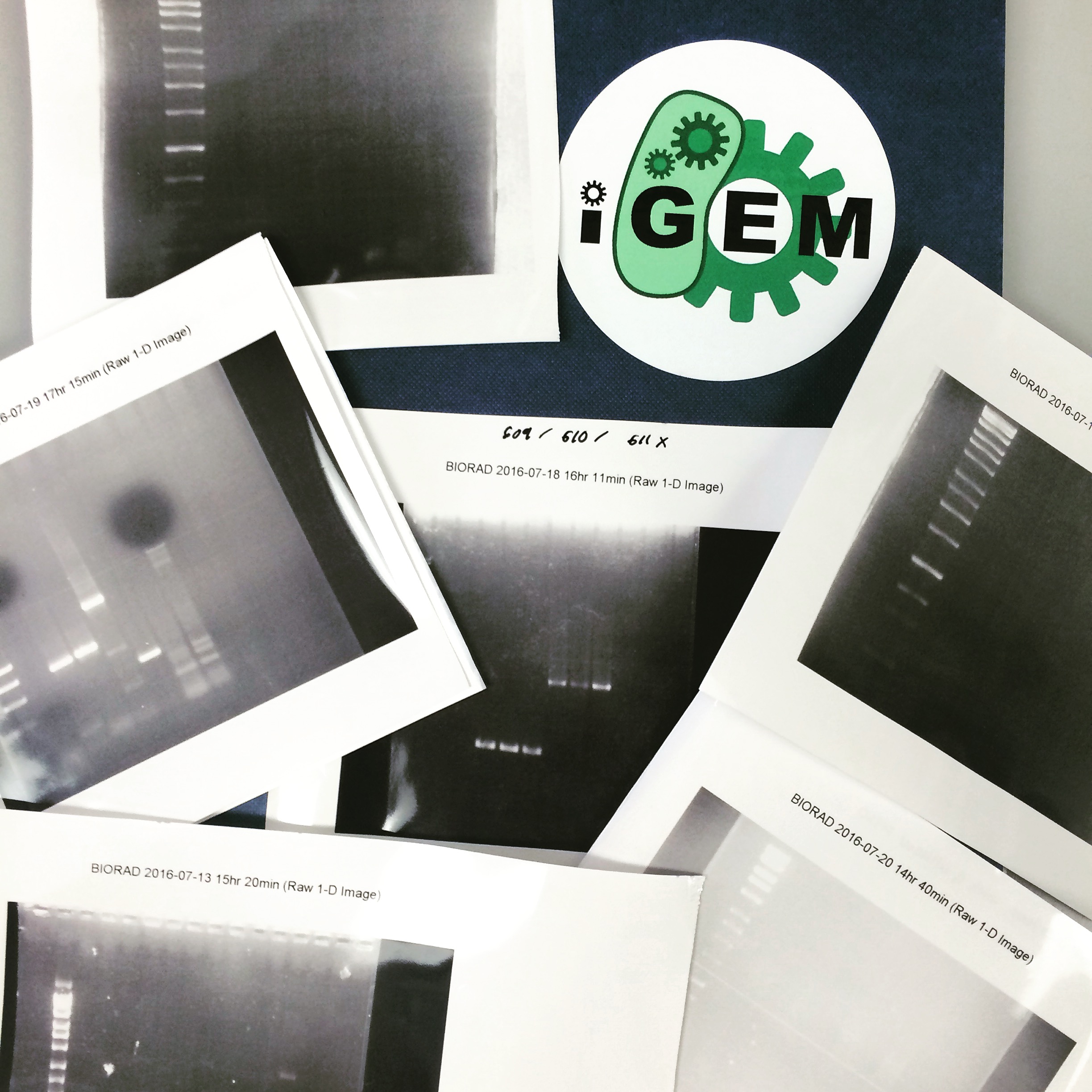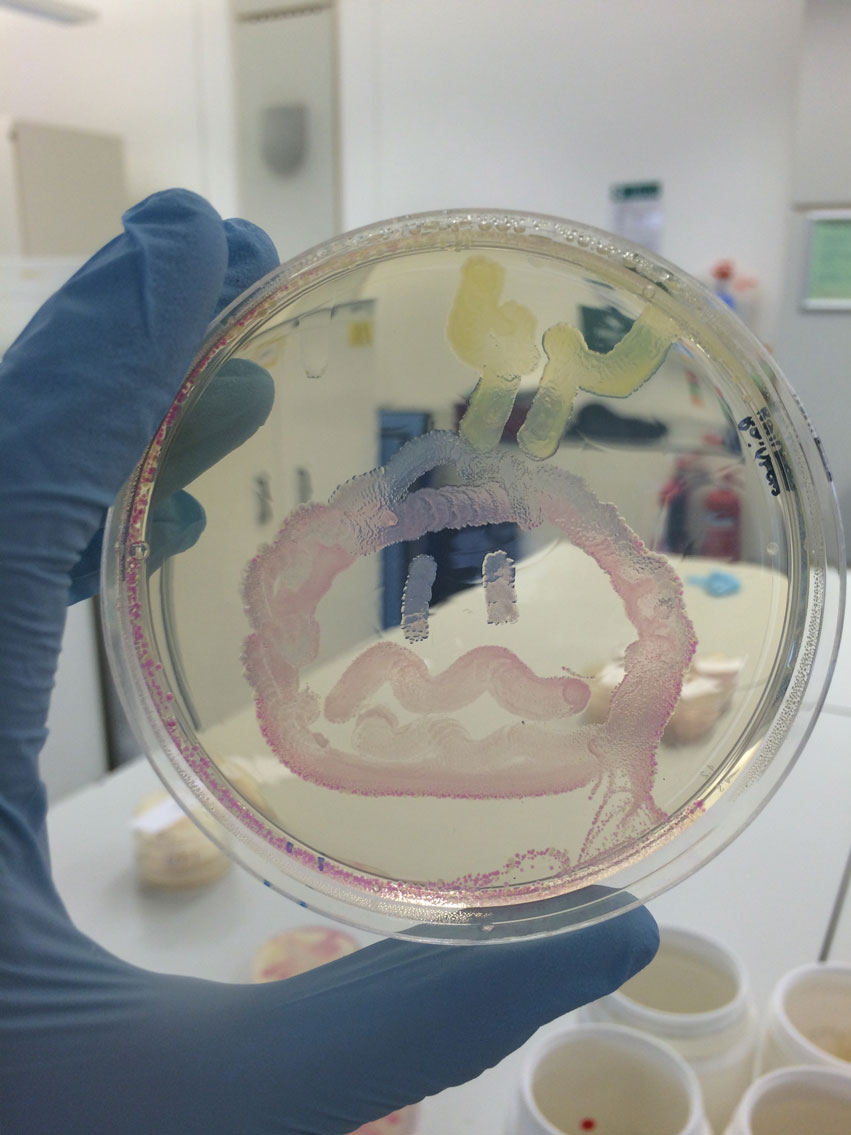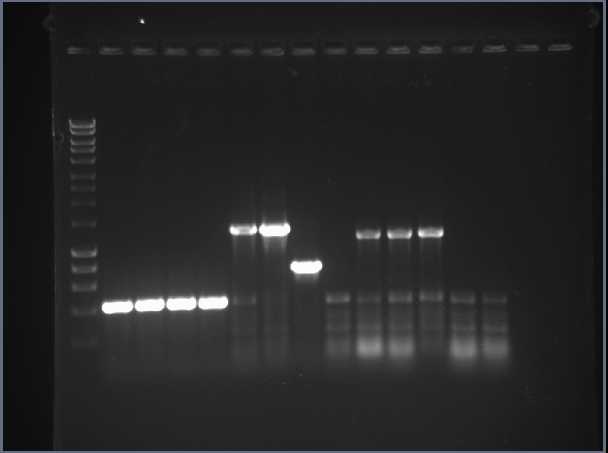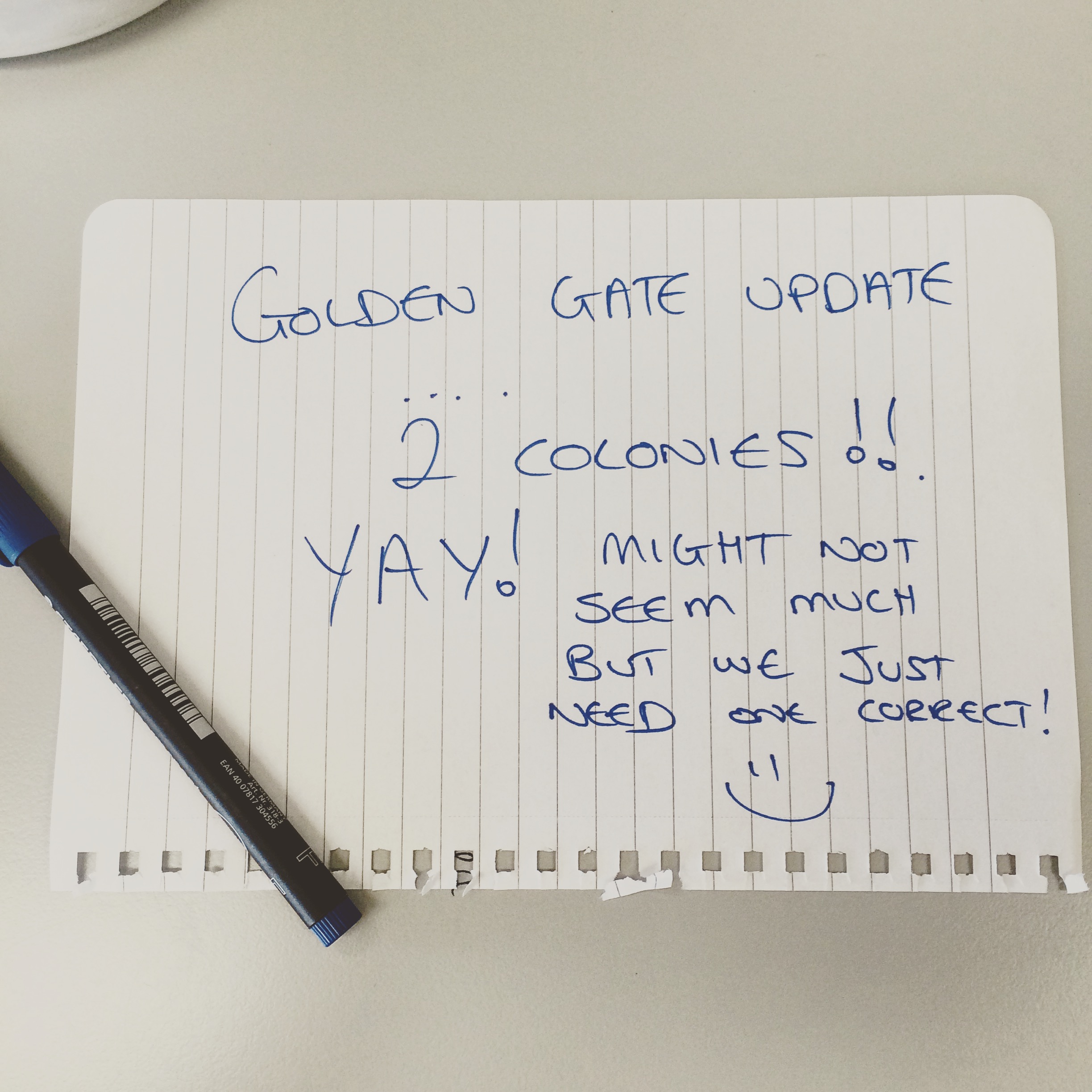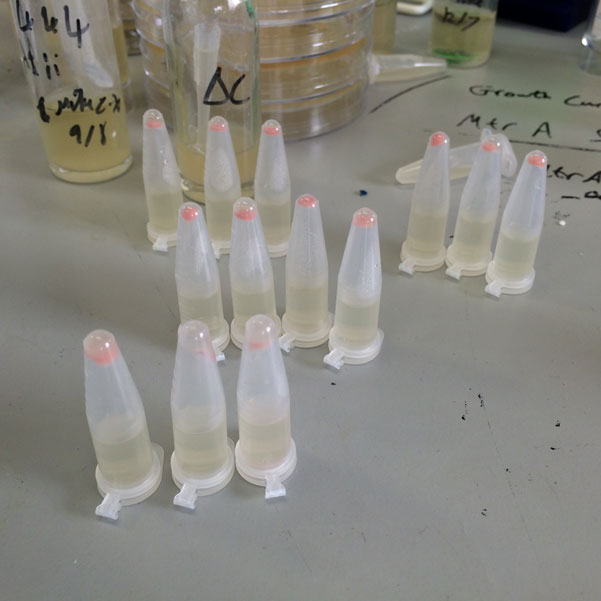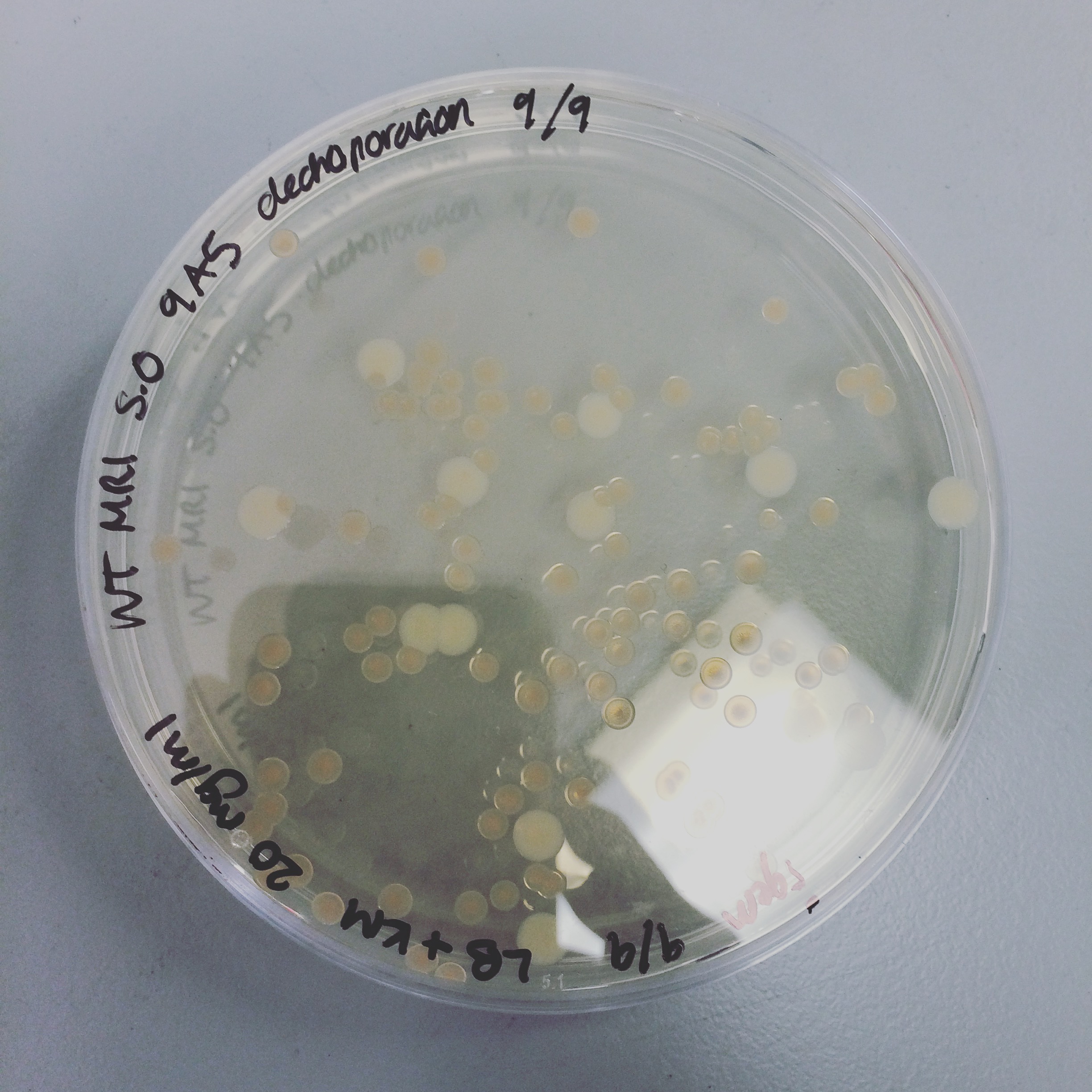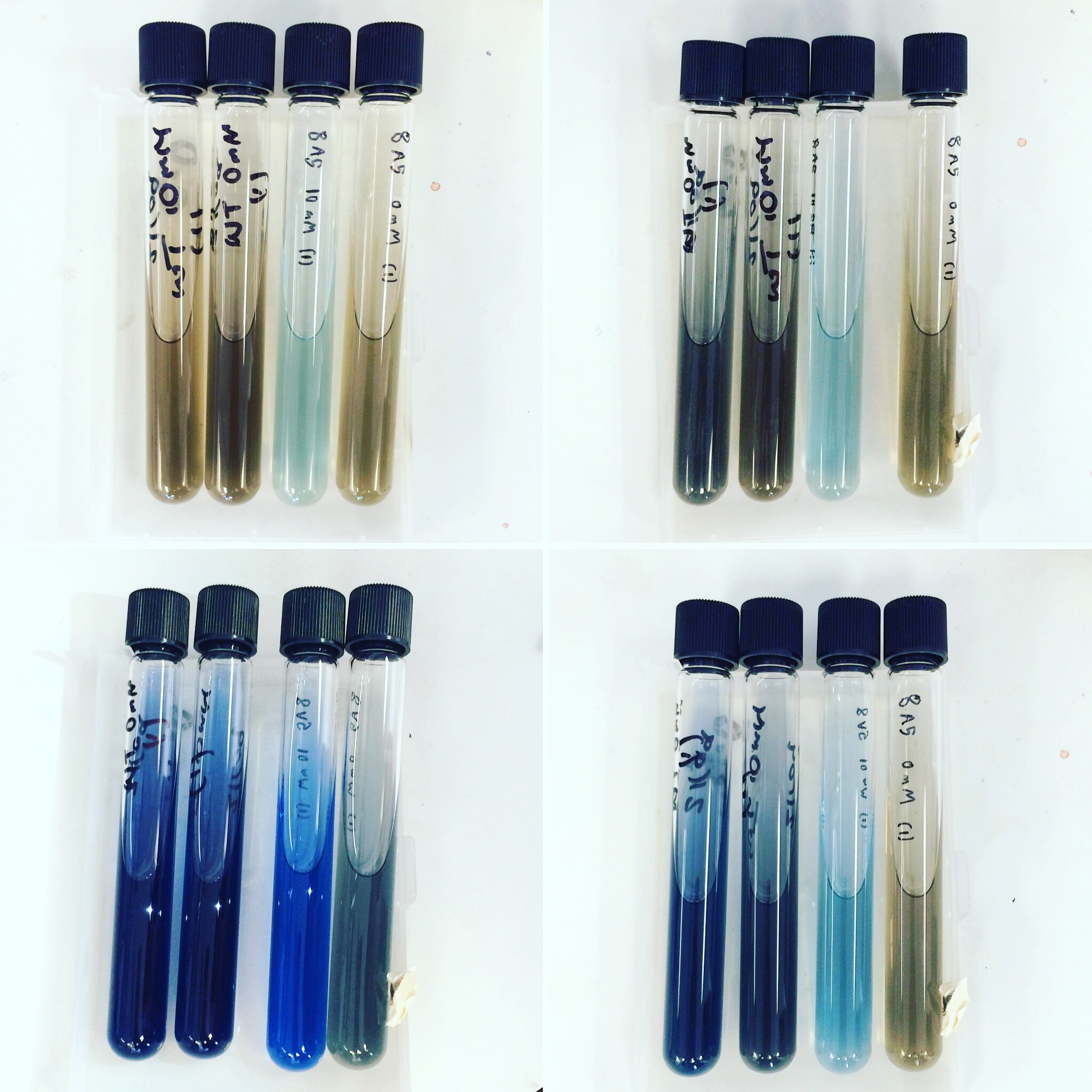Notebook
Week 1 4.07-8.07
At the start of the week, team members completed a safety induction for the lab. The first experiment used the iGEM standard RFP BioBrick (BBa_J04450) to transform E. coli. For our planned outreach activity, seven coloured BioBricks from the iGEM 2016 distribution kit were identified. E. coli was transformed with these BioBricks, and then plated to determine which cells had been transformed successfully.
Week 2 11.07-15.07
Successful transformants were selected and used to inoculate LB media, these samples were to be used for the children's Summer School. Consequently, they were mini prepped to obtain the plasmid DNA. Alongside this, the PCR protocol was optimised by experimenting with annealing temperatures. The HydC/Fdh, HydA, HydB C- and N-terminus genes and RFP BioBricks (Bba_J04450) were digested with EcoR1 and Pst1. Samples were run on a gel to observe complete digestion and then extracted and purified.
Week 3 18.07-22.07
For the Summer School: Blue, Pink, RFP (Red Fluorescent Protein) and GFP (Green Fluorescent Protein) colonies were inoculated. Various drawing utensils were tested on plates to determine which one would be best for the children to use. After speaking to the student leader of UCC (iGEM Cork) it was decided to go with cotton buds. For our main project, the cleaned-up PCR products were run on a gel to check the PCR amplification was successful. 2.5µL DMSO was added to the HyaC N- and C-terminus DNA to minimise non-specific amplification, but did not make any difference. The FeFe gene inserts were digested along with RFP to obtain the BioBrick vector. Gel extraction and purification of the gene inserts yielded low concentrations, these were repeated.
Week 4 25.07-29.07
Vials of the ‘paint’ and cotton buds were prepared for the human practices activity. GFP, RFP, Pink and Blue were inoculated and grown overnight to use the following day for the activity. The PCR amplification was repeated for FeFe gene inserts. These were then digested, extracted and purified from the agarose gel. FeFe genes inserts were ligated with the BioBrick vector. The ligations reactions were set up with different ratios of vector and insert (1:1 and 1:3) and incubated overnight. These were transformed into α-select Gold Efficiency E.coli cells by heat shock the following day and plated out. Four plates showed colonies and successful ligations i.e. HydC/Fdh 1:1, HydC/Fdh 1:3, HydA 1:3 and HydB C-terminus 1:3. Digestion reactions were set up for the NiFe genes: HyaC, HyaA and HyaB N- and C-terminus followed by ligations.
Week 5 1.08-5.08
The successful colonies for HydC/Fdh, HydA and HydB C-terminus were inoculated in 10ml LB overnight. Following mini-prep plasmid purification, PCR confirmed correct ligations. The gel results showed unexpected sizes for some of the samples and suggested that some of the samples had been mis-labelled. DNA from new overnight cultures of HydC/Fdh, HydA and HydB C-terminus were obtained by mini-prep and a restriction digest was carried out to verify the results. Digests of HydB N-terminus, HyaC, HyaA, HyaB N-terminus and HyaB C-terminus were set up, however following gel purification concentrations were too low, thus transformations did not yield results.
Week 6 8.08-12.08
We repeated the PCR amplification of FeFe units along with NiFe genes inserts. With new primers for HyaB N- and C-terminus gene insert. Gel showed successful amplification of FeFe gene inserts and HyaB N-terminus. The FeFe subunits were digested alongside samples of RFP DNA. Samples were extracted and purified from the gel, however nanodrop results showed extremely low concentration for HydA. It was decided this would be repeated. Afterwards, HydA and HydB N-terminus were ligated into the pSB1C3 vector and frozen for later transformation. More J04450 was inoculated and mini-prepped as a source of vector. HydC/Fdh, HydB C-terminus and HyaA was successfully ligated into pSB1C3 and digest confirmed a mix-up in sample labels however bands did correspond to correct gene inserts.
A practice tri-parental conjugation trial was conducted following protocol, using samples obtained from a PhD student in the lab
We conducted experiments to practise growing bacteria for creating anaerobic growth curves and to practise using the gas chromatograph. We grew wildtype MR-1 and double knock out (LS473) Shewanella strains in anaerobic conditions for 24 hours in hungate tubes then analysed the headspace gases using gas chromatography to calculate the hydrogen yield.
Week 7 15.08-19.08
Due to the uncertainty of the identity of these potential BioBricks, 606, 608 and 610 plasmid DNA samples were sent for DNA sequencing confirmation. The results proved that these samples were successful BioBricks, but that samples had been mislabelled. The frozen samples of ligated 607 and 609 were transformed successfully into α-select E. coli and colonies grown. A colony from each was inoculated, grown up overnight and mini-prepped.
We conducted a practice arabinose induced protein expression trial using samples from a PhD student in the lab. SDS-PAGE gels were set up and used to practice analysing protein expression. The tri-parental conjugation of RFP (J04450) Biobrick into S. oneidensis was set up for the following week.
Week 8 22.08-26.08
Golden Gate Cloning of FeFe Hydrogenase subunits could be done. pBAD vector would allow controlled expression of the FeFe Hydrogenase in downstream assays. Additionally, using pBAD allowed us to get around the reported issues of S.oneidensis not recognising the pSB1C3. The Golden Gate cloning was done successfully, which allowed us to test out our construct in S.oneidensis. Only 605 and 612 (NiFe subunits) were PCR amplified successfully, and cloned into pSB1C3.
Tri-parental conjugation of RFP (J04450) and GFP (K584001) Biobricks into S. oneidensis was attempted but was unsuccessful.
Week 9 29.08-2.09
Inoculations of FeFe Hydrogenase gene cluster, HydABC, was made and mini-prepped to send off a DNA sample for sequencing. Some of the remaining DNA was run on a gel against the pBAD vector to observe correct ligation. HydABC was transformed back into -select E.coli for more cells. The NiFe gene inserts were transformed and plated, but was unsuccessful. Additional RFP digests showed high amounts of smearing, thus an overnight digest was done and used to ligate the NiFe gene inserts.
Wild Type S. oneidensis, LS473 S. oneidensis NiFe and FeFe hydrogenase double knockout and LS498 S. oneidensis FeFe hydrogenase knockout was inoculated in preparation for transforming the plasmid containing HydABC into S. oneidensis. Triparental conjugation was then performed to transform 8A5 (pBAD vector with HydABC C-terminally tagged) and 9A5 (pBAD vector with HydABC N-terminally tagged) into all three strains of S. oneidensis.
Week 10 5.09-9.09
Ligated 605 and 612 did not yield any colonies. Found an old sample of mini-prepped 612 transformations, however diagnostic digest results showed that it was not our gene insert. This was confirmed by sending the sample off for sequencing. Stock of DNA was made by inoculating and mini-prepping more samples of the HydABC. A c ulture with our FeFe hydrogenase cluster was used in conjugation efforts by Team 2.
The triparental conjugation was continued from last week, however there were no S. oneidensis colonies containing the plasmid. Attempted electroporation to deliver the plasmid with HydABC into S. oneidensis. The first attempt did not yield any results, but the second attempt gave colonies of wild type MR1, double knockout, and FeFe knockout S. oneidensis with both 8A5 and 9A5.
Week 11 12.09-16.09
Attempted to start again with NiFe catalytic subunit cloning. PCR amplified with new primers and digested with new source of EcoR1 and Pst1 as digests with our enzymes showed high amounts of smearing. Digest gel showed a band for 612 but not for 611. Ligations were set up to be transformed the following week. Alongside 611 and 612, it was decided to excise HydABC out of the pBAD vector and ligate that into pSB1C3.
Mini-prepped colonies of the electroporation were sent off for sequencing. Results showed that only wild type S.oneidensis MR-1 has successfully taken up the HydABC C-terminally tagged i.e. 8A5, construct. Triparental conjugation and electroporation was continued but did not yield results. Protein expression trials (induced with 0mM, 1mM and 10mM arabinose) of the WT with 8A5, E. coli with 8A5 and 9A5 were performed using SDS-PAGE and western blot techniques.
Week 12 19.09-23.09
NiFe Hydrogenase subunits and HydABC were ligated and transformed into E.coli cells. All plates had colonies, however diagnostic digest showed that our insert was not in them. Most likely due to incomplete digestion of RFP. As DNA of 611 and 612 was low, we ordered new DNA. This was used to re-attempt cloning of 611 and 612 into pSB1C3.
The triparental conjugations and electroporation’s from the previous week did not give any positive results. Protein expression trials (induced with 0mM, 1mM and 10mM arabinose) using SDS-PAGE and Western Blot were repeated for WT 8A5 and E. coli with 8A5 and 9A5.
Week 13 26.09-30.09
Redid digest of RFP to obtain a source of vector for new ligations for NiFe gene inserts and HydABC cluster. Transformed these into E.coli cells. All plates showed ligations, colonies were inoculated and mini prepped to perform diagnostics on. Results showed correct ligations of all NiFe gene inserts, yielding more BioBricks.

